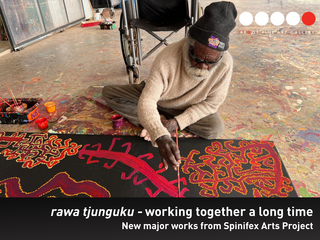1 / 2
21-212 (2021)
Acrylic on Linen
Kulyuru | 21-212
Acrylic on Linen
230 x 200cm | 90.55 x 78.74in
ENQUIRE
Nyangatja kapi pulkana munu ini kulyuru ka nyangatja ngura Minyma tjutangku palyanu ka tjana tjawani tjawani kukaku kuniya kaya kuniya ngurini. This is a huge rockhole. It’s called Kulyuru and is a creation site of the Seven Sisters. The sisters were searching for a large carpet python and kept digging down while searching for the kuniya and created this waterhole.
Kulyuru belongs to the Seven Sisters Tjukurpa. The women travelled from Kuru Ala to Kulyuru in pursuit of a kuniya (carpet python) and he fled down a hole at Kulyuru. The women eager for a feed, first dug a small hole, but he wasn’t there. This formed the Rockhole called Watakala,. They dug at another place, but he wasn’t there either. At Kulyuru they dug and dug, deeper and deeper. All of a sudden, the Kuniya flew up out of the rock hole. The sisters caught the python and cooked it up and ate it. Once they tasted the cooked meat, they knew something was not right as they meat tasted strange. They realised that this was Wati Nyiru (the man called Nyiru), who had transformed his body into that of the python. Wati Nyiru was a lustful old man who had his eye on Kampakutja the eldest sister. He had been following the women over vast tracks of country waiting for his moment to pounce.
From Kulyuru the women flew to Minyma Nyanpi Rockhole, where they painted their breasts in traditional ceremonial designs and performed a sacred dance before flying further west and eventually up into the sky where they became the constellation of the Seven Sisters.
Kulyuru belongs to the Seven Sisters Tjukurpa. The women travelled from Kuru Ala to Kulyuru in pursuit of a kuniya (carpet... Read More
Appeared in this exhibition
25-454 (2025)
Acrylic on Linen
Kulyuru | 25-454
Acrylic on Linen
200 x 230cm | 78.74 x 90.55in
ENQUIRE
Lennard Walker dives easily into his depiction of the significant site of Kulyuru, situated in the northeastern area of the Great Victoria Desert. As well as being a physically majestic deep rocky gorge that holds a large water source, it also forms part of the Kungarangkalpa Tjukurpa (Seven Sisters Creation Line). This is a far reaching narrative that traverses great swaths of Spinifex Country as it follows the journey of a group of young women as they evade the lustful pursuit of an older man, Wati Nyiru. Nyiru has the metamorphic powers of transformation and is constantly tricking the women on their travels. At Kulyuru, the women see the tracks of a prized food- a Kunyia (carpet python) and begin vigorously digging for it, only to find after catching, cooking and ingesting the snake, that it was Nyiru all along. Here Lennard has depicted the wana (digging stick) piercing into the centre of the gorge, the wana being a key tool used by the sisters to dig their way in to the centre of Kulyuru.
The women then vomit the kunyia back up and make their escape to nearby Minyma Ngampi where they complete their journey by flying up into the sky to become the Pleiades star cluster.
Read Less![Australian Indigenous (Aboriginal and Torres Strait Islander) artwork by LENNARD WALKER of Spinifex Artists. The title is Kulyuru. [21-212] (Acrylic on Linen)](https://media.redotgallery.com/stockroom/gallery/k/kulyuru-5969-MEDIUM.png)

![Australian Indigenous (Aboriginal and Torres Strait Islander) artwork by LENNARD WALKER of Spinifex Artists. The title is Kulyuru. [25-454] (Acrylic on Linen)](https://media.redotgallery.com/stockroom/gallery/k/artwork/l/kulyuru-6365-MEDIUM-1.jpg)